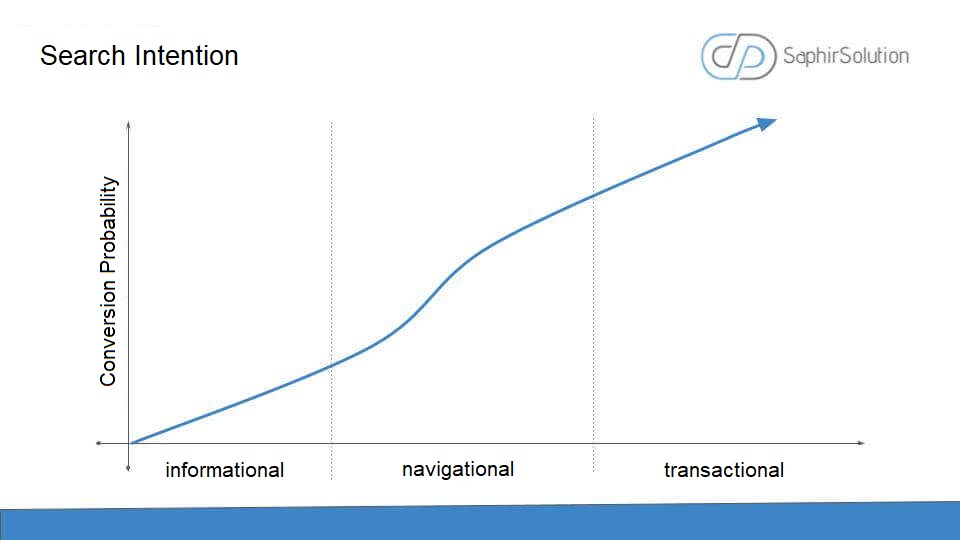More performance with search intention analysis
Classic keyword research focuses on KPIs such as search volume, click prices, and the competition that prevails with this keyword. Good keywords have a high search volume and a low click price as a result of low competition. Such keywords are exciting for search engine optimization , as they can be used to generate a solid reach and get website visitors.
In this blog post, we would like to introduce another evaluation dimension that allows us to evaluate our keywords from a conversion perspective.
Search intention – What moves our user?
Behind every search query is an intention. For example, a user who searches for “buy sports shoes” is interested in a selection of sports shoes and a shopping opportunity. Brands or preferences (color, texture, or features) are not included in these searches. The longer the search phrase, the more likely it is that the user is further along in the decision-making process. For example, if the user searches for “Puma running shoe cheap red”, this long-tail search phrase is much more meaningful in terms of the searcher’s intention. The expectations of such a search phrase should be met accordingly by the target pages so that the user experience is positive and a sale / inquiry is more likely.

Against this background, it makes sense to also examine search phrases for the search intention. There are basically 3 search types:
1. Informational search phrases
In this case, the user is looking for more information about his intention. Such a search phrase could be in this context: “Sports shoes for jogging.” At this point, you can see a very early interest in buying, but the customer is only indirectly helped by an overview page with offers for sports shoes. Rather, the expectation is (at least in large parts): Show me a page that compares different sports shoes with each other and tells me which model suits me.
2. Navigational search phrases
This form of search phrase contains search intentions in which the searcher has already determined some features that his future product should fulfill. An example search phrase would be: “Puma sports shoe”. The user now expects an overview of various Puma sports shoes, which differ in their characteristics. Here, the user can browse and may find a model that meets his expectations. The probability of conversions with navigational search phrases is therefore higher than with informational search phrases.
3. Transactional search phrases
Transactional search phrases have the most exciting search intention for sales since the user already signals here that he wants his needs covered. Such a search query could, for example, be in the context of the topic: “buy sports shoes”; the corresponding target page would be an overview page with corresponding sports shoes and various feature filters. The purchase request is integrated into the search phrase, and thus the conversion probability is correspondingly high.
4. Mixed forms
Mixed forms consisting of navigational and transactional search intentions are particularly exciting from a conversion perspective. At this point, the conversion probability is correspondingly high. An example: “Buy Puma sports shoes” At this point, we already know which offer the user is interested in. If the target page is pre-filtered accordingly and the user expectation is met, we get the highest probability of a deal with this form of search intention.
Evaluation of existing data
In the Analytics report (Acquisition AdWords), you can evaluate various keywords, provided conversion tracking is integrated. At this point, the conversion rate decides whether the entered keywords make sense.
Example data:
1458 clicks on the keyword “sports shoes”
1389 sessions on the keyword “sports shoes”
3 transactions on the keyword “sports shoes”
€703.45 costs for the keyword
0.2% conversion rate
€341.12 net sales
With this data, you can quickly see that this keyword makes no sense from a conversion point of view and is not profitable for the online shop. But the probability of the purchase could have been determined before the investment of €703.45, and the budget could have been better distributed accordingly.
Conclusion on the search intentions
Long-tailed search phrases do not have a huge search volume, but are more suitable for a good keyword setting due to the mass of keywords, which should be the basis for SEO and SEA strategies.
Use the considerations of search intent analysis to assess keywords in advance for the probability of a conversion and think about the landing pages with which you can serve the search intent and thus maximize the user experience for the customer. We would like to help you.





